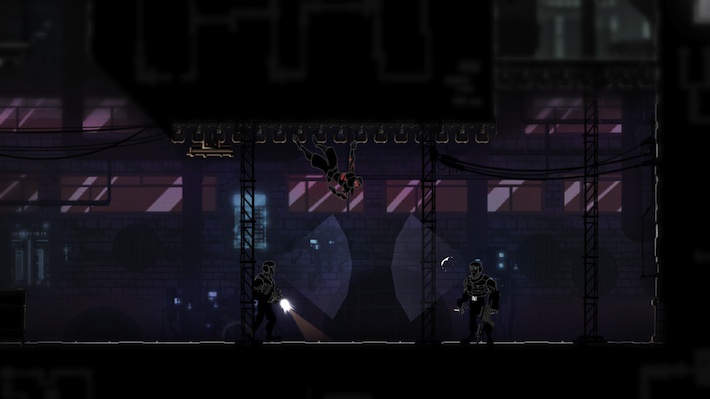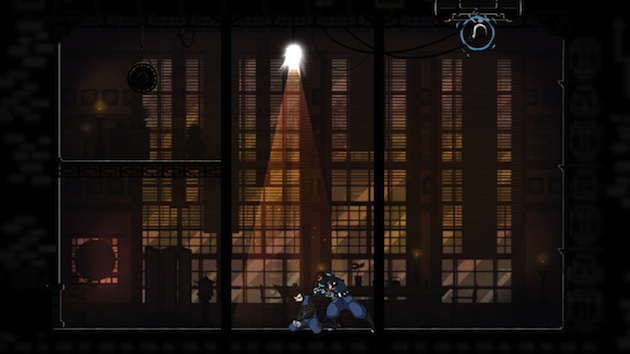“Accessibility” is often a dirty word when it comes to video game development. For many, it implies developers are dumbing down a game to reach the widest possible audience. But for Klei Entertainment, accessibility is something they just stumbled upon when designing the mechanics for Mark of the Ninja, its upcoming 2D stealth game for Xbox Live Arcade.
Part of what makes a stealth game a “stealth” game is a complex series of interlocking systems that can be intimidating at first glance. This usually involves a lot of trial-and-error experimentation, which for some can lead to frustration.
“What if we just kind of accelerated people past that [learning curve], to the interesting part where you have the knowledge of those systems to [treat them] just like a tool in your arsenal,” said Nels Anderson, game designer at Klei Entertainment. “Because when you have scarce resources, it’s kind of like the weird schizophrenia of stealth games, where it’s, ‘Oh, you need to do a lot of experimentation to understand how all these systems work,’ but…you’re a glass cannon and so taking risks can generally be very punitive. We just want to make sure that was not the case [in our game].”
However, to graft these mechanics to a 2D plane — since you share the same line of sight with the enemy, you really can’t “hide” as you would in other stealth games — requires a fundamentally different approach. Rather than just copy and paste what worked in other titles, Klei introduced its own set of revolutionary new mechanics while refining those the genre is already known for.
What’s New
Fog of war: Except for your immediate surroundings, the rest of the level is purposefully hidden under a fog of war: Any buildings or spaces beyond your line of sight has a soft, hazy blur that only clears once you approach. You can’t see any enemies that may be lingering in this fog, unless you’ve seen them before; if you have, a red outline of their body shows their last known position. Similarly, if you break from the enemy’s line of sight after being seen, your last known position is visible to them.
This doesn’t mean you’re completely blind to what these areas hold. Your ninja’s keen senses helps you see these foes without actually being in the fog. If you lean against a door or peek through an air vent, you can see the contents of a room before deciding to infiltrate it.
Sound rings: Whenever a noise is loud enough for enemies to hear, colored rings pop up onscreen to illustrate just how far the sound travels; the ring’s diameter reflects how loud the sound is. If any part of the circle overlaps with a nearby guard, he will hear it and break his patrol route to investigate the source.
Whether a flock of birds flies away, or you shatter any lights in the area to remain cloaked in darkness, or are running too loudly — you’ll know exactly how loud the noise is going to be.
Freezing time: A pivotal part of your bag of stealth tricks is the dart, a projectile that’s useless for damaging your enemies but is really helpful for distracting them — whether you’re throwing them at lights, gongs, or anything that makes noise. When aiming these darts, the game freezes; not only can you select multiple targets, but their this displays their sound rings as well.
“If you’re climbing across the ceiling dropping down into some room, and you want to break through the lights so you land in darkness, you should be able to do that, right?” Anderson asked. “As a character, the ninja should be able to do that…. Rather than having the difficulty being perfectly executing the stealth, the difficulty should come out of, ‘Okay, use this in an interesting way to get past these challenges.’”
Visibility: Continuing the trend of conveying as much visual information to you as possible is the way your color palette (or that of the enemy) changes when you appear under a source of light. Stay in the shadows and you’re practically invisible; your suit is completely black, with just a touch of red wrapped in a white outline. Once illuminated, you’ll see that your suit is actually more nuanced, with blues, blacks, grays, and other colors.
It’s a simple but effective mechanic that immediately lets you know how visible you are.
A.I. with permanent levels of awareness: As members of an elite private military company, the guards you’re up against in Mark of the Ninja’s modern-day setting are not stupid. Though you can kill almost any enemies in the game with one timed stealth attack, they do take notice when one of their own goes missing. This behavior is split into three tiers: At first they’re oblivious and walk along their patrol route without knowing you’re there; next, they can become suspicious (with a yellow question mark above their heads) if they hear a loud noise coming from somewhere, and they go off and investigate it; lastly, if they saw you (and have a red exclamation point), they become aware of your presence. They won’t forget it.
Their animation poses completely change as they become much more aggressive, frantically looking back and forth even as they return to their normal routine. But you can use this to your advantage — if they see you actually killing one of their comrades, either through a stealth kill or with something laying around the area, the witnesses become terrified, and they will shoot at any noise they hear.
In this state, they’re also easier to kill and manipulate: Anderson told me how he lured one of these terrified folk into a group of other guards by making noise at their location. The agitated enemy would go crazy and start shooting in that direction, even if it meant killing his own crew.
What’s refined or the same
Alert countdown: If you become too reckless and alert the guards, a small red countdown box appears as they look for you. For anyone who’s played a game in the Metal Gear Solid franchise, this may seem familiar.
“Sometimes, it’s just kind of like, ‘Well, it works just fine, so we’ll go with that,’” said Anderson. “Clarity is not to be understated.” [Laughs]
Stealth kills: You’re a ninja, so you won’t survive a full-on assault from automatic weapons. So you must rely on your ability to pull off the stealth kill when the guards least expect them: Once you get close enough, time slows to a crawl as button prompts appear above you. If you wait too long or press the wrong combination, the enemy still dies, but in a noisy way that could alert any others nearby. Pull it off correctly, and aside from blood splatter, you’re absolutely silent.
You can hide bodies in a variety of areas, though once you stash them someplace, you can no longer use that spot to hide.
Vision cones: Illustrating just how far enemies can see, vision cones provide useful data for when you’re planning your movements. In Mark of the Ninja, the vision cones present a much more broader range of enemy behavior than just the usual spot-and-shoot.
“If you’re far enough away, and they just catch a glimpse of you, they’re just going to try and get closer,” said Anderson. “But it isn’t like the guy sees you and he’s immediately going to start shooting at you. I always find that a little bit artificial.”
Playing as a pacifist: One of the ultimate challenges for any stealth game is trying to complete it without actually killing anybody. Unfortunately, everything you do as a ninja is deadly, and it’s just not possible to knock an enemy unconscious with your sword. You’ll have to avoid them entirely.
With the exception of three characters you have to kill to satisfy the game’s narrative, every other enemy in the game doesn’t need to die. You do get bonus points for avoiding kills when looking at your graded performance at the end of a level, but it’s far from being the only way to earn the best possible score.
“So there isn’t really, like if you’re trying to get the best score, there isn’t necessarily a best [way to do it],” said Anderson. “It’s not like, ‘Oh, make sure you don’t kill anybody, or make sure you kill everybody.’ They’re both valid, and I thought that was very important.”
[vb_gallery id=517750]

